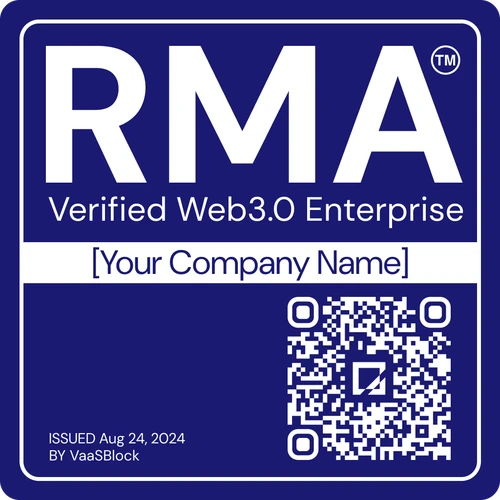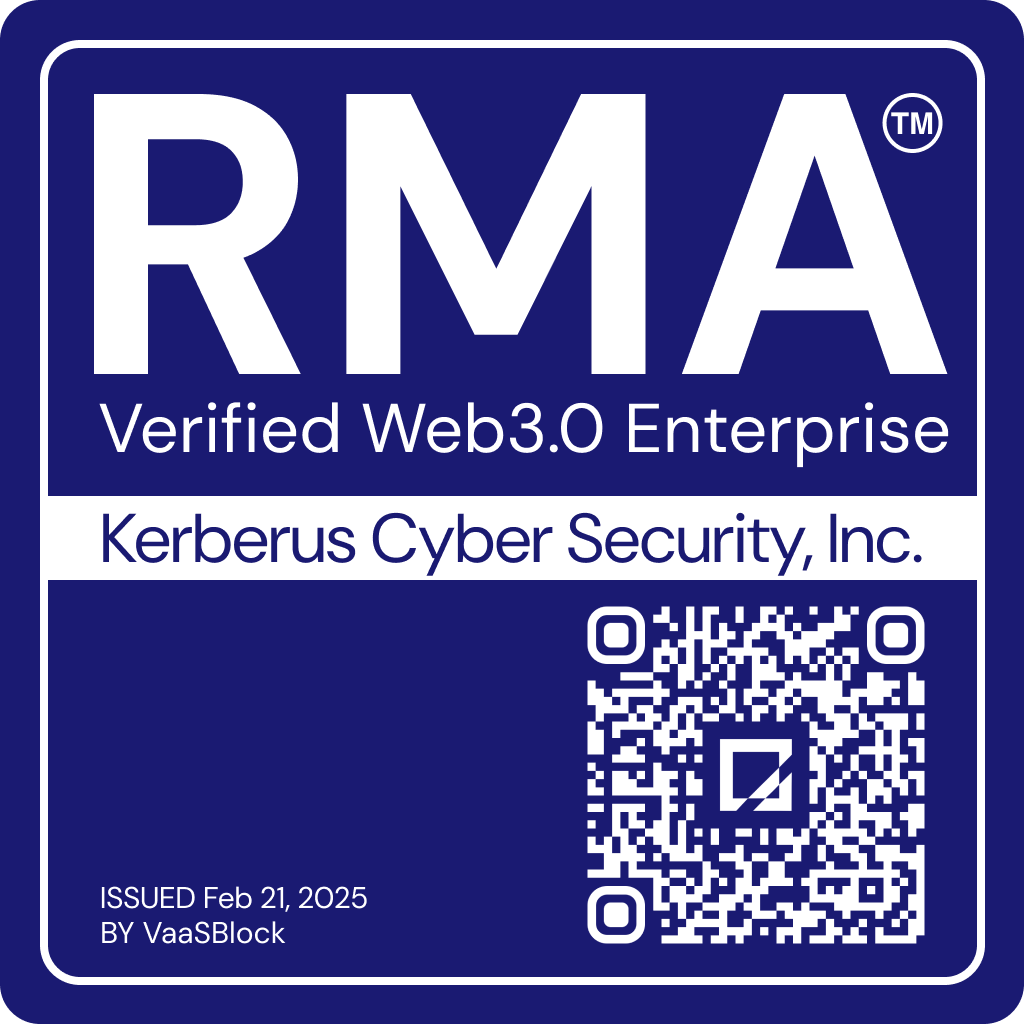
Kerberus
Risk Management
?Risk Management
The RMA™ is a blockchain credibility certification assessing governance, transparency, security, and results, providing trusted verification for businesses in Web3.
Analysis based on information collected and audited by VaaSBlock.

RMA™ Status: ✔ Active
Verification of 6 major compliance criteria.
Technology
?Technology
A collection of public facing information, data collected through partners and our own tools view we present a projects technology in one place for easy verification.
Analysis and testing of tech infrastructures.
Marketing
Alpha?Marketing
Top level look at a projects marketing capablities currently in alpha this section will grow to show quickly how a project promotes itself and the effectiveness.
Screening of user base and community feedback.
Background
?Background
Using multiple public facing sources across the web view a summary of a projects purpose, key achievements and general overview.
Collection of basic administrative documentation.
Risk Management
Last Updated
2025/12/01
Transparency
Transparency Score
Algorithmic assessment of a project’s transparency level, using multiple public data points to measure its commitment to compliance, documentation, and clarity in communication.
Transparency Score
Category Rank
A ranking that positions the organization among its industry peers, evaluating its relative performance based on key compliance, credibility, and transparency indicators.
Category Rank
Kerberus Cyber Security, Inc. vs Security & Identity
VaaSBlock Rank
A global ranking that compares the organization against all entities listed on VaaSBlock, reflecting its overall credibility, transparency, and operational performance versus the full Web3 ecosystem.
VaaSBlock Rank
Kerberus Cyber Security, Inc. vs All Listed Organizations
Transparency
Transparency Score
Transparency Score
Algorithmic assessment of a project’s transparency level, using multiple public data points to measure its commitment to compliance, documentation, and clarity in communication.
Category Rank
Kerberus Cyber Security, Inc. vs Security & Identity
Category Rank
A ranking that positions the organization among its industry peers, evaluating its relative performance based on key compliance, credibility, and transparency indicators.
VaaSBlock Rank
Kerberus Cyber Security, Inc. vs All Listed Organizations
VaaSBlock Rank
A global ranking that compares the organization against all entities listed on VaaSBlock, reflecting its overall credibility, transparency, and operational performance versus the full Web3 ecosystem.
RMA™
Contract – ![]() 0x89584b…89bc2048
0x89584b…89bc2048
Mint date – 02/20/2025
Token – ![]() 0x89584b…89bc2048/31
0x89584b…89bc2048/31
Full Report – ✘ Not available
Learn how to verify an RMACorporate Governance
The verification of fundamental governance, organizational structure, including verifying the entity’s legal registration and adherence to local laws and regulations.
Corporate
Governance

Team Proficency
Evaluation of an organization’s personnel, ensuring that crucial team members possess the expertise and dedication necessary to execute current business models and scale effectively.
Team
Proficiency

Technology & Security
Assessment of the organization’s technological framework, including blockchain integrations (where relevant), system architecture, and overall IT infrastructure.
Technology
& Security

Revenue Model
Comprehensively evaluation of a company’s income-generating strategies (how do they make or intend to make money), ensuring financial robustness and sustainability.
Revenue
Model

Results Delivered
The Results Delivered component of the RMA™ audit comprehensively evaluates an organization’s ability to achieve its goals and honor its commitments.
Results
Delivered

Planning & Transparency
The Planning and Transparency component of the RMA™ audit offers a thorough assessment of how an organization manages its workflow and prepares for unexpected challenges.
Planning &
Transparency

RMA™ Announcement
VaaSBlock proudly announces that Kerberus Cyber Security, Inc., creators of the leading Web3 user security extension, has earned the prestigious Risk Management Authentication (RMA™). This marks the f… [Read More]
Organization Representative
Alex Katz, CEO of Kerberus
Quote
“Receiving the RMA™ is a major milestone for us at Kerberus. Our business exists to empower users with enterprise-grade security in the fast-changing Web3 world. This recognition validates our approach and drives us to continue innovating. We are proud to lead in Web3 security and remain committed to transparency and excellence.”
Technology
Website
Domain First Registered – September 2002
SSL Status – ✔ Secure
Source Code
N/A
Marketing
No Chain No Gain™ Podcast ⛊
[NCNG ep.150] Online Safety 101 – This week, @metrokatz from @Kerberus shares his top 3 tips for navigating the internet safely.
— VaaSBlock (@vaasblock) April 18, 2025
Simple. Actionable. Essential. For everything else, there’s #Sentinel3 — download it now on https://t.co/Otw04U1Las
🎙️ Check @NCNG_io for bi-weekly… pic.twitter.com/4dFtvUy17d
4K Views
https://x.com/NCNG_io/status/1904742432450760788
5.1K Views
PR Impact
PR Impact
VaaSBlock provides estimations to the impact that traditional digital media can have on a project. This is an early release; more areas of PR are planned in future versions.
Search Terms ? Search TermsThese are the terms we discovered the article for on page one of Google. | Est. Traffic ? Estimated TrafficWe estimate how much traffic an article will get. Generally, our estimations are slightly higher than those of more established tools. We are working on the algorithm all the time, and results could change. | Est. Value ? Estimated ValueBased on the estimated traffic we generate an estimation for what this traffic would have cost to generate if you tried to target these users with ads. The positions for the article on google and the location of the traffic are the major factors in this estimation. | |||
|---|---|---|---|---|---|
Toxaemia: Rejected Souls Of Kerberus (Limited Edition) (LP) source: jpc.de | Toxaemia: Rejected S… Seen 2025-02-20T19:00:00.000Z Toxaemia: Rejected Souls Of Kerberus (Limited Edition) (LP) source: jpc.de | Organic | jpc.de | ||
TOXAEMIA — Rejected Souls of Kerberus LP RED, 25,99 € source: hrrecords.de | TOXAEMIA — Rejected… Seen 2025-06-04T19:00:00.000Z TOXAEMIA — Rejected Souls of Kerberus LP RED, 25,99 € source: hrrecords.de | Organic | hrrecords.de | ||
A1073104085 source: Thalia | A1073104085… — A1073104085 source: Thalia | Organic | thalia.de | ||
TOXAEMIA – rejected souls of kerberus CD – cudgel | Der ultimative Metal Online Store source: cudgel.de | TOXAEMIA – rejected … — TOXAEMIA – rejected souls of kerberus CD – cudgel | Der ultimative Metal Online Store source: cudgel.de | Organic | cudgel.de |
| Est. Traffic | Est. Value | ||
|---|---|---|---|
Toxaemia: Rejected S… Seen 2025-02-20T19:00:00.000Z | |||
TOXAEMIA — Rejected… Seen 2025-06-04T19:00:00.000Z | |||
A1073104085… — | |||
TOXAEMIA – rejected … — |
Background
Organization Name – Kerberus
Category –  Security & Identity
Security & Identity
About
powered by irmaAI
irmaAIKerberus has evolved dramatically over the past three years, becoming one of the most influential security layers in the Web3 ecosystem. What began as a lightweight browser extension now operates as a… multi-layered, AI-enhanced security infrastructure provider protecting millions of transactions across EVM and Solana.
Founded in 2022, Kerberus quickly recognized the accelerating sophistication of wallet drainers, phishing kits, malicious dApps, and approval-based exploits. In response, the company built Sentinel3, a real-time defence engine that detects high-risk signatures, malicious JavaScript injections, approval drainers, gasless traps, mempool-timed scams, and honeypot behaviours before users ever sign a transaction.
Over the last 36 months, Kerberus expanded far beyond its origins by acquiring multiple micro-teams and codebases specializing in:
• malicious script detection
• drainer-kit fingerprinting
• DeFi honeypot pattern recognition
• AI-based transaction simulations
• Solana exploit analytics
• phishing-domain clustering
This consolidation of niche expertise allowed Kerberus to grow into a full Web3 security stack, offering protection not only to retail users but also to exchanges, Web3 games, DeFi protocols, and AI-agent trading platforms.
Enterprise Adoption & Ecosystem Growth
Kerberus now supports:
• EVM (Ethereum, Base, BNB Chain, Polygon)
• Layer-2 ecosystems
• Solana behavioural scanning
• Cross-chain exploit heuristics
• On/off-chain metadata correlation
• Risk-scoring APIs used by wallets and dApps
It has become one of the few security extensions offering enterprise-grade APIs, allowing platforms to embed the Kerberus risk engine directly into swaps, marketplaces, minting flows, on-ramps, agent-based trading modules, and DAO governance portals.
This expansion coincided with a surge in Web3 security threats, including:
• 678% YoY growth in wallet drainer kits
• $3.86B lost to phishing + approval scams (2023–2024)
• 40,000+ malicious domains flagged in Q3 2024
• 6× rise in DNS hijacking and ad-spoofing attacks
Kerberus’ behavioural analysis approach—far more advanced than simple blocklists—positioned it as a critical defence layer across ecosystems.
Global Presence & Recognition
In 2025, Kerberus became a King Sponsor at Token2049, signaling its emergence as a globally recognized security brand. The platform’s visibility at large Web3 events strengthened its role as a frontline defence provider for both institutions and retail participants.
Kerberus also earned an RMA™ (Risk Management Assessment) certification from VaaSBlock, validating its governance, documentation, testing processes, operational controls, and security transparency. This independent verification is a significant differentiator in an industry where many security tools lack oversight or formal standards.
Insurance-Backed User Protection
In partnership with third-party providers, Kerberus introduced indemnity-backed coverage for eligible users. If Kerberus marks a transaction as safe and the user suffers a loss, the plan may reimburse affected funds—creating a rare trust mechanism in Web3 security.
Constant Innovation in a High-Threat Landscape
Several threat patterns Kerberus actively detects include:
• ice-phishing approval drainers
• gasless drainer signature traps
• malicious NFT marketplace clones
• contract-switching liquidity rugs
• Solana Jito-bundle drainers
• DNS-spoofed wallet interfaces
• fake AI-agent trading UIs
• ERC-20 poisoning loops
Kerberus’ Sentinel3 engine uses AI-assisted behavioural models to analyze risk before a signature is submitted—catching threats even when they are brand-new or not yet listed in threat databases.
A Mature Organisation in an Immature Industry
Kerberus is now one of the few security tools with:
• a real incident-response workflow
• a multi-chain threat database
• public documentation
• independent certification
• enterprise onboarding
• an indemnity-backed pro tier
In an environment where builder fatigue is high, exploit sophistication is rising, and drainer kits are becoming professionalized SaaS products, Kerberus acts as both guardian and infrastructure backbone for Web3 users and platforms.
What is Kerberus?
Kerberus is a multi-chain Web3 security platform offering real-time protection against wallet drainers, phishing dApps, malicious transactions, and exploit patterns.
Is Kerberus safe to use?
Yes. Kerberus never accesses or stores private keys. It operates purely at the browser and transaction-simulation layer.
What chains does Kerberus support?
Kerberus supports EVM chains (Ethereum, Base, BNB Chain, Polygon), multiple L2s, and Solana.
How does Kerberus protect against wallet drainers?
Through behavioural detection, signature analysis, mempool simulation, and malicious script fingerprinting.
What is the Sentinel3 engine?
Sentinel3 is Kerberus’ AI-powered security engine that evaluates on-chain behaviour, signatures, and off-chain signals to detect risk in real time.
Does Kerberus detect NFT scams?
Yes—fake mints, contract-swapped collections, malicious marketplaces, and phishing NFT UIs.
Does Kerberus simulate transactions before signing?
Yes. It performs pre-signature risk checks and attempts to catch malicious contract interactions before they execute.
How accurate is Kerberus?
Kerberus uses behavioural heuristics and real-time threat intelligence, not static blocklists, giving it higher accuracy against novel threats.
Why is Kerberus RMA™ certified?
Kerberus passed a six-part independent assessment covering governance, testing, security, transparency, and operational maturity.
Does Kerberus offer insurance or reimbursement?
Yes. Certain plans include indemnity-backed coverage if a transaction marked safe results in loss.
Is Kerberus better than Pocket Universe or Fire?
Kerberus is more enterprise-focused, multi-chain, RMA-certified, and supports behavioural scanning across EVM + Solana.
Who uses Kerberus?
Retail users, exchanges, Web3 games, wallets, AI-agent trading platforms, and DeFi protocols.
Does Kerberus block malicious domains?
Yes, including DNS hijacks, fake wallet sites, and phishing campaigns.
Does Kerberus slow down the browser?
No—it’s optimized to run lightweight, in milliseconds.
Can Kerberus be used for enterprise integration?
Yes, via Kerberus APIs used for risk scoring and pre-signature validation.
Why was Kerberus a King Sponsor at Token2049?
To expand visibility within exchanges, institutional partners, and security-sensitive Web3 companies.
Does Kerberus support Solana?
Yes—with behavioural scanning tuned for Solana-specific drainers and Jito bundles.
Does Kerberus offer team or governance transparency?
Yes—public documentation, independent certification, and published methodology support transparency.
Read More
Creation Date
December 2025
Headquarters
Delaware, United states
Organization Maturity Level
Growing Business
RMA™ Type
Self-Assessment
Useful Links
Website – kerberus.com
Notable Achievements
2022
Launch
2023
Rebranded from Mintdefense
2023
Launched Sentinel3
2024
Acquistion of Fire
2024
Transaction Coverage with Fairside
2023
Recognition for Zero customer loses
- vaasblock.com /
- Security & Identity /
- Kerberus










